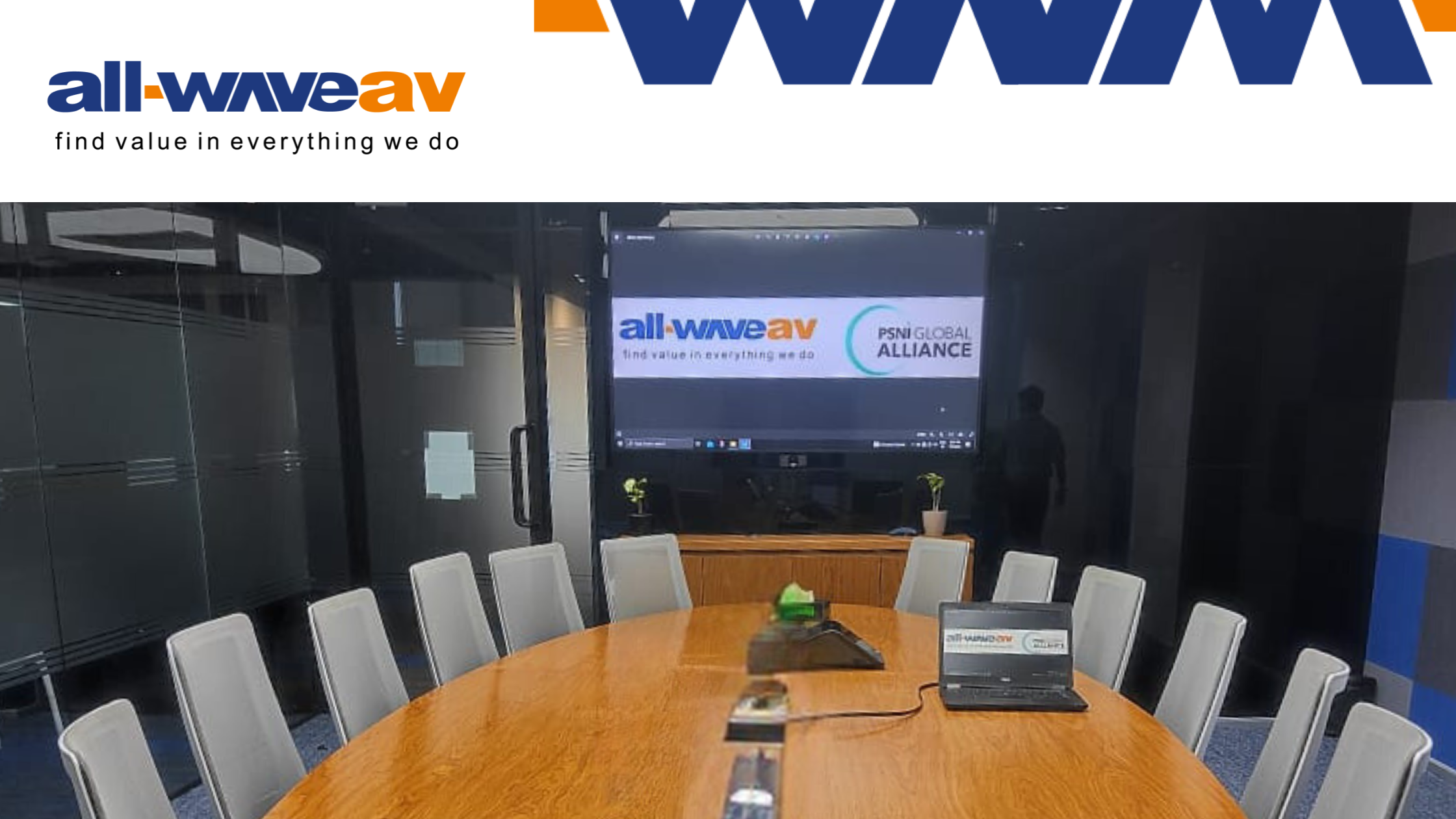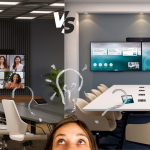Creating an audiovisual high-performance meeting room design is no longer just a luxury—it’s a necessity for businesses aiming to foster collaboration, innovation, and productivity. A well-designed audiovisual meeting space enhances communication, ensures comfort, and supports the technology that modern conference rooms, boardrooms, and meeting rooms rely on.
But what exactly defines a high-performance meeting room design?
Here, we break down the five key elements that every meeting room design needs to support effective and engaging meetings.
Display: Size Matters!
A high-performance meeting room demands a display that fits the room’s dimensions and provides clear visuals to everyone present. The display should be large enough for participants seated at the back of the room to see. It should also offer the resolution necessary to present data, images, and videos with sharp clarity.
- Choose a display size that matches the room’s dimensions, ensuring all participants have an unobstructed view. Mount the screen at eye level for optimal viewing.
- Opt for 4K or higher resolution displays for sharp and clear visuals, especially in larger rooms where details matter.
- Incorporate interactive whiteboards or touchscreens to engage participants and make presentations more dynamic.
A well-implemented video conferencing system enhances remote collaboration, ensuring that virtual participants experience the same high-quality visuals and engagement as those physically present.
Audio: Crystal-Clear Sound in Every Corner
Clear visuals matter, but subpar audio drastically diminishes the effectiveness of your meeting room setup. The goal is to ensure that all participants, whether in-person or remotely, can hear and be heard without any strain.
- Install high-quality speakers that deliver clear, balanced sound across the room, ensuring every participant hears and is heard with perfect clarity.
- Use advanced microphone arrays with noise-cancellation features to capture voices accurately while minimizing background noise and echo.
- Leverage DSP technology to automatically adjust audio levels, eliminate feedback, and enhance speech intelligibility during meetings.
Companies investing in AV solutions can integrate cutting-edge audio technology, ensuring their meeting rooms are equipped with the latest advancements in sound management and speech clarity.
Lighting: Don’t Let Poor Lighting Cast a Shadow on Your Ideas
Lighting is a frequently overlooked aspect of audiovisual meeting room design. It plays a critical role in creating an environment that is conducive to productivity.
Poor lighting can lead to eye strain, fatigue, and headaches, diminishing the effectiveness of your meeting room setup.
- Install dimmable LED lights that can be adjusted to suit different meeting types and screen needs, reducing glare and eye strain.
- Use blinds or shades to control natural light, preventing it from washing out displays or causing glare.
- Implement smart lighting controls that automatically adjust based on the time of day or the type of meeting being held.
Additionally, multi-purpose spaces like a digital cafeteria can benefit from adaptable lighting setups, ensuring a seamless transition between casual discussions and formal presentations.
Acoustics: Clear Audio Is Non-Negotiable
Even the best audio systems can struggle in a room with poor acoustics. Echoes, reverberation, and background noise can all interfere with sound clarity, making it difficult for participants to focus and engage fully. Proper audiovisual acoustic treatment is essential for maintaining the clarity and consistency of your audio.
- Install sound-absorbing panels on walls and ceilings to reduce echoes and prevent sound from bouncing around the room.
- Use carpets, rugs, and upholstered furniture to absorb sound and minimize noise reflections.
- Implement sound masking technology to cover ambient noise and create a consistent audio environment.
A well-balanced AV system ensures that even in acoustically challenging spaces, sound remains clear, professional, and optimized for engagement.
Connectivity: A Good Smart Room Is the One That Is Always Connected
In today’s digital workplace, seamless connectivity is a cornerstone of high-performance audiovisual meeting room design. Connecting with the remote participants and sharing content wirelessly. Meeting room setups should be equipped to handle it all smoothly and efficiently.
- Integrate AV equipment with platforms like Zoom, Microsoft Teams, or Google Meet to facilitate seamless virtual and hybrid meetings.
- Use wireless presentation devices like Barco ClickShare or AirPlay to allow participants to share content without the need of any cables and connectors.
- Implement a central control system, such as Crestron or AMX, to manage all AV components, lighting, and connectivity from a single interface.
AV consultants play a crucial role in designing smart meeting spaces, ensuring that every element—from connectivity to control systems—functions flawlessly to enhance the overall meeting experience.
Conclusion
When it comes to designing a high-performance audiovisual meeting room, attention to detail in every aspect is crucial. From display size to connectivity, each element makes a significant difference. The goal, therefore, is to create a space that is not only functional but also fosters creativity, communication, and collaboration. By prioritizing the five key elements of audiovisual meeting room design—display, audio, lighting, acoustics, and connectivity—you can transform any meeting room setup into a hub of productivity and innovation.
Ultimately, the right design can elevate the experience of every meeting, ensuring that your team stays engaged and focused. Whether you’re building a new meeting room from scratch or upgrading an existing one, each option presents unique challenges and opportunities. By keeping these elements in mind, you can create a space where ideas truly thrive.





